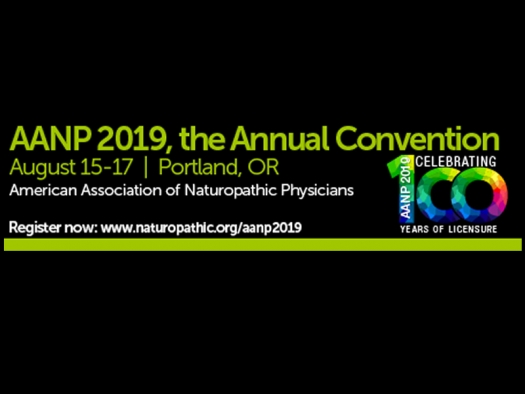Highlights from the 2019 American Association of Naturopathic Physicians (AANP) Conference
Staying informed on the ever-changing landscape of medicine and natural therapies can be downright impossible. One way to keep current on research and clinical practice is to attend professional conferences. Still, attending meetings takes time and money, and there are so many conference options to choose from.
That’s why part of what we do at the Foundation for Alternative and Integrative Medicine is to bring conference summaries to you. One of those conferences is the annual American Association of Naturopathic Physicians (AANP) convention and expo. We went to the 2019 AANP conference so we could bring the conference highlights back to you.
As the largest gathering of naturopathic doctors (NDs) in the United States, the 2019 AANP convention attracted more than 700 attendees to the Oregon Convention Center on August 15-17. Featuring more than 40 educational sessions, the conference delivered clinical pearls by the second.
When it comes to heart disease, did you know that norepinephrine and other neurotransmitters might be early detection biomarkers of chronic inflammation? When it comes to thyroid disease, did you know that researchers have found insulin resistance to be a cause of hypothyroid? When it comes to memory, did you know that a 2018 human study found curcumin to decrease brain amyloid accumulation and improve memory?
Other topics at the conference included estrogen detoxification, attention deficit and hyperactivity disorder (ADHD), small intestinal bacterial overgrowth (SIBO), and pediatric autoimmune neuropsychiatric disorders associated with streptococcal infection (PANDAS). All of the conference recordings are available for purchase through Onsite Recordings.
In this article, we will take you on a deep dive into three of the topics discussed at the AANP conference. We chose these topics because they were particularly unique, new, and relevant. Read on to learn more about herbal defenses against Lyme disease, homeoprophylaxis, and wildcrafted herbs you should be using.
Herbal defense against Lyme Disease
Lyme disease is a bacterial infection that can affect anybody who has sustained a bite from a tick. In some cases, the infection is limited to a bulls-eye rash, fever, and brief illness. In other cases, the infection leads to years of health problems.
Post-treatment Lyme disease (what some call chronic Lyme disease) is riddled with complexities. Often 7-9 different microorganisms are present in a patient with Lyme disease, many of which are difficult to treat with antibiotics. Also, the spirochete that causes Lyme disease is one of 80% of infections that create biofilms – making them difficult to eliminate.
NDs and other holistic practitioners take a variety of approaches to patients infected with Lyme disease. Many times, they combine conventional antibiotic therapies with herbal or homeopathic remedies. In people who continue to struggle with issues for years after the acute infection, however, even an integrated approach is not foolproof.
Given the challenges with eradicating Lyme disease once it has taken hold, many people live in fear of ticks and tick bites. If there were a remedy we could keep in our backpacks or first-aid kits to reduce the risk of ongoing problems after an encounter with an infected tick, much of this anxiety might subside.
There might be a remedy that fits that description. It’s called Biocidin and was the topic of a session at the AANP conference entitled “Lyme, Mold, and Dysbiosis – Connections to Chronic Illness.”
Presented by Jocelyn Strand, ND, the session covered the research and science behind Biocidin – a botanical formulation that includes bilberry extract, noni, milk thistle, echinacea, goldenseal, shiitake, white willow bark, garlic, grapeseed extract, black walnut, raspberry, fumitory, gentian, and four essential oils.
Biocidin was formulated in 1987 by Dr. Rachel Fresco, an Oriental medicine practitioner. Research on the product began in the early 1990s in collaboration with Great Smokies Diagnostic Labs Comprehensive Digestive Stool Analysis. After six years and more than 200,000 patient samples, Biocidin proved effective against numerous bacteria, yeast, and fungal species. The broad-spectrum antimicrobial activity of Biocidin has been confirmed by other laboratory and clinical studies over the last 28 years.
There are five stages of biofilm development, and the botanicals in Biocidin can address all of them. In 2013, research at University of Binghamton showed that Biocidin was effective against biofilms of both yeast and bacteria.
A laboratory study that was conducted by Leona Gilbert, Ph.D., in 2016 demonstrated the specific activity of Biocidin against Borrelia burgdorferi – the pathogen that causes Lyme disease. In as little as 10 minutes, the botanical formulation caused 97% cell death to the organisms. This study also found that the liposomal delivery of Biocidin entered cells more readily than liquid delivery.
Strand shared several case studies in her presentation at the AANP conference. Some of the most striking were situations where she had used Biocidin within the first three days of a tick bite (but after symptoms started to appear). Biocidin was taken for two weeks, and in both of the cases shared by Strand, acute symptoms resolved within 12 hours and remained resolved six months later.
You can learn more about Biocidin on the Bio-Botanical Research®, Inc. website.
Homeoprophylaxis for epidemic outbreaks
The best recommendation that the Centers for Disease Control and Prevention (CDC) has to offer for the prevention of epidemic diseases is the routine administration of shots. However, shots are not available for all diseases, they are not readily available to all people around the world, and they take time for the body to mount an effective immune response.
Because homeopathic remedies are believed to work according to a similar principle as shots, many people ask whether homeopathic remedies can be taken instead.
The short answer is no. Homeopathic remedies are not a substitute for CDC recommendations. “Homeoprophylaxis,” which literally means “prevention by homeopathy,” is a confusing term that has been misinterpreted by many. Taking homeopathic remedies as a routine measure instead of shots will not work.
However, homeopathy does have a long history of use during epidemics – both in people who have become infected with a disease and in people who are at risk of exposure.
In a session entitled “Homeopathic Prophylaxis and Treatment of Epidemics and Pandemics,” Dr. Sharum Sharif, ND, presented 165 slides packed with hundreds of studies backing up the efficacy of homeopathy during epidemic outbreaks. For example, homeopathy has a good track record in the context of Dengue fever, malaria, and pneumonia. You can find a summary of some studies of homeopathy in epidemic diseases at the National Center for Homeopathy.
Sharif emphasized one main point repeatedly throughout his presentation: the use of homeopathic remedies for epidemic diseases is very different than their use for chronic or constitutional illness. In the context of epidemic disease, the best method is to find the genus epidemicus (the remedy that best matches the majority of cases). The second-best method is to find the individual remedy suited for the patient. The third-best method is to use a nosode (a diluted preparation of the infectious material). The last approach is combination remedies.
The hierarchy of best approaches (beginning with the genus epidemicus) applies to the use of homeopathic remedies for both the treatment AND the prevention of epidemic disease. It’s important to note that we are not talking about taking remedies on a routine basis instead of shots. We are talking about using remedies DURING an outbreak to prevent the spread of disease.
Sharif offered clinical pearls about specific homeopathic remedies that are often useful during epidemics. For example, remedies that are helpful for the shock and fear during epidemics include gelsemium, arsenicum, arnica, aconite, and phosphoric acid. He also gave an enthusiastic recommendation for DrHomeo – a website to reference when seeking information about the use of homeopathic remedies in the context of specific diseases.
Wildcrafted herbs you should be using
In the modern-day use of botanicals to support health, we tend to use herbs that have been researched and popularized. These include herbs like echinacea, ginseng, ginkgo, and turmeric. However, many popular herbs are cultivated in sensitive environments, need to be transported overseas, and are not sustainable into the future.
“There’s a tendency for us to get excited about exotic things,” said Dr. Eric Yarnell, ND, at his presentation at the AANP conference. “We need to ask if it is sustainable and consider the ecological impact.” In his presentation, entitled “10 American Herbs You Don’t Know but Should be Using,” Yarnell encouraged attendees to get out into nature and wildcraft local herbs. Here are a few herbs he introduced to the audience.
Betony (Pedicularis spp.) grows in the mountains in the western U.S. It is hemiparasitic, meaning that it takes nutrients (but also toxins) from surrounding plants. When betony grows around grasses or trees, it is safe to wildcraft. If it grows around poisonous plants (like arnica), however, it should be avoided. Betony relaxes the nervous system, skeletal muscles, and the pelvic floor. It is an excellent alternative to the well-known herb, kava kava (Piper methysticum).
Pacific madrone (Arbutus menziesii) is a tree that grows along the northwest coast of the U.S. and prolifically in Portland, OR. The best way to wildcraft the plant is to wait for healthy and green leaves to fall off the tree. Madrone leaf has been shown to contain five times the amount of arbutin than the commonly known herb uva ursi (Arctostaphylos). Like uva ursi, madrone has an affinity for the urinary tract, where it is helpful for people with chronic urinary tract infections. In chronic situations, Yarnell suggests that it works in part by eliminating harmful pathogens from the gut.
Sweet flag or calamus (Acorus calamus) grows in wetlands along the eastern coast of the US. According to Yarnell, there is no herb like it. Calamus is a nootropic, which means that it supports cognitive function and is a protector of the nervous system. The herb has traditionally been used in Korea for seizure disorders, and Yarnell has successfully used it in cases of spina bifida – a situation that does not respond well to most therapies.
Bush clover (Lespedeza capitata) is a shrub in the pea family that grows in the tall grass prairies of the Midwest US. It is protective for the kidneys and, according to Yarnell, works best to support healthy kidney function in people with normal aging of the kidneys. Whereas most of the herbs discussed in Yarnell’s presentation have little to no research, this herb was evaluated in clinical trials in Europe in the late 1960s – demonstrating a beneficial effect on serum creatinine levels.
Although Dr. Yarnell unabashedly encouraged people to wildcraft their herbs, he does sell many of these locally harvested herbs through Heron Botanicals.
More info from the 2019 AANP Conference
If you’re searching for more clinical pearls from the 2019 AANP conference, check out this article at the Natural Medicine Journal: Naturopathic Doctors Celebrate 100 Years of Licensure at the 2019 AANP Convention. If you want more detailed information from educational sessions, you can purchase any or all of the conference recordings from Onsite Recordings.



